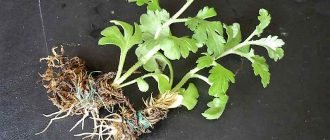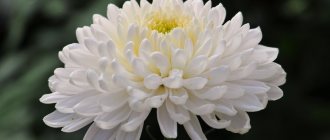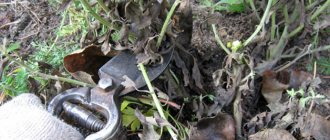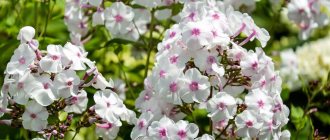General description of Korean chrysanthemum
The culture was bred artificially by breeders. Garden chrysanthemum is taken as the basis. Perennial plants are highly resistant to frost. Therefore, they can be grown even in regions with harsh climates. Korean chrysanthemum is divided into low, medium and tall. Accordingly, the bushes reach a height of 30, 50, 100 centimeters. The plant produces a large number of flowers of various colors. The buds of early-blooming Korean chrysanthemums begin to bloom in August. You can admire the beautiful flowers until frost.
Additional Information! Chrysanthemum is called a short-day plant due to the fact that the inflorescences begin to form when daylight hours are waning.
How to properly care for garden crops?
Caring for a crop such as the perennial garden chrysanthemum, as well as planting, is accessible to any gardener. It is imperative to take care of proper and timely watering, because these plants are very sensitive to insufficient moisture. This will be evidenced by the formation of rare and small flowers, as well as woodiness of the stem. But excess water should also be avoided, as the root system may begin to rot.
Stick to the golden mean (the soil under the bush should be slightly moist all the time), and also pay attention to the weather (watering should be more frequent in hot weather, and less frequent in cold weather)
Cover the plant for the winter, for example, with dry branches or spruce branches.
Chrysanthemums need fertilizers of both mineral and organic types. It is advisable to apply mineral fertilizer every two to three weeks. Moreover, during the growing season, nitrogen should predominate in the fertilizing composition, and then the emphasis is on potassium and phosphorus. Use fertilizer on the basis that for two square meters of planting it is enough to dilute 40 grams of the selected product in ten liters of water. In addition, three times a season you need to feed the flower with mullein infusion (it is diluted in a ratio of 1:10 with water). Approximately one liter of solution is poured under each plant. The next morning (that is, after fertilizing), the soil needs to be loosened.
Planting and caring for perennial chrysanthemum in the open ground is a feasible job for any gardener. There are no difficulties as such. It is enough to know how to properly care for chrysanthemums in the garden so that the plant enjoys long and abundant flowering. Take into account the subtleties - and the plant will become a full-fledged element of the landscape design of your personal plot.
Features of cultivation
Korean chrysanthemum is grown in open and closed ground. The first option is the most common. Although the plants bloom only in late summer, they need to be cared for in early spring.
Requirements for place and soil
An area for planting chrysanthemums is selected that is well lit by sunlight. In the shade, the shoots stretch out, become thinner, and the flowers become smaller. There should be no stagnation of moisture in the area, otherwise the flowers may become infected with fungus. Therefore, the bushes are planted at a certain elevation, and drainage is laid in the planting hole.
Loam is best suited for planting chrysanthemums. If the soil is sandy, frequent watering of the plants will be required. The soil acidity level should be neutral. Nutrients are added to depleted soil.
Dates and patterns for planting chrysanthemums
Korean chrysanthemum is planted in open ground in spring or autumn. It takes root easily and does not require special care. In the spring, planting is carried out after the threat of return frosts has passed. In autumn, bushes are planted a month before the expected onset of frost.
Planting is done as follows:
- dig holes 30 centimeters deep at a distance of 30-50 centimeters;
- drainage is laid on the bottom, then a layer of earth mixed with fertilizer;
- bushes are planted and covered with soil;
- water abundantly.
The ground around the bushes is sprinkled with mulching material.
Favorable and undesirable neighbors for a flower
Chrysanthemums coexist well with each other. Bushes of the same size are planted nearby. When planting other crops nearby, you need to take into account the shape of the leaves and the color of the buds. Plants should fit together beautifully. Then the flower bed will look harmonious.
Plants that are significantly taller cannot be planted next to Korean chrysanthemums. Otherwise, they will block the sun's rays and take nutrients from the ground. It is undesirable to plant plants of the Ranunculaceae family nearby. Marigolds and sage, on the contrary, are able to drive away harmful insects from chrysanthemums.
Watering and fertilizing
Watering and fertilizing play an important role in caring for plants. Irrigation is carried out after the top layer of soil has dried. Plants especially need moisture in summer. For irrigation use settled water. Overhead irrigation is not permitted. In this case, the bushes may become infected with fungal diseases. Nitrogen fertilizers are used 2-3 weeks after spring planting. They promote active growth of bushes. Then potassium-phosphorus substances are used to promote the formation of a large number of buds. During the flowering period, fertilizing is not applied.
See also
Description of the best varieties of reticulated irises (Denford), planting and care, propagation
Read
Important! Nutrients are applied after thoroughly moistening the soil.
Loosening and mulching the soil
After watering, the soil around the plants is loosened. The procedure prevents the formation of a crust on the soil surface. After loosening, air and water easily penetrate the root system. To retain moisture, the tree trunk circle is sprinkled with mulching material. To do this, use straw, mown grass, and chopped tree bark.
Trimming
When 7-10 leaves appear on the bushes, pinch the top of the plant. The procedure promotes abundant growth of side shoots. The top of the plant can be rooted and planted on the site. To do this, the cut stalk must be 7-10 centimeters long. In addition, sanitary pruning is carried out during the season. Remove broken, diseased, dry shoots. When frost hits and the flowers fade, they are cut off along with the shoots. Only stumps 8-10 centimeters high are left.
Expert opinion
Zarechny Maxim Valerievich
Agronomist with 12 years of experience. Our best country expert.
Ask a Question
Note! There are varieties of spherical chrysanthemums that do not require formative pruning.
Preventative treatments
The culture has good immunity. It can become ill due to improper care or unfavorable climatic conditions. Weeding can be a good way to prevent the appearance of diseases and pests, since weeds can carry insects and pathogenic microorganisms.
Insects
Chrysanthemum can be favored by aphids and spider mites. Insects feed on cell sap, weakening the bushes. To get rid of pests use "Aktellik". The culture may also be favored by snails and slugs. “Ulicide” is used against them.
Diseases
Bushes can be affected by powdery mildew, rust, and gray rot. They lose their decorative appearance and may die completely. Copper-containing preparations are used to prevent and treat diseases. It is impossible to get rid of a viral infection: affected plants are dug up and burned.
Preparing for winter
Korean chrysanthemums are famous for their good winter hardiness. Most varieties overwinter safely in open ground. It is enough to sprinkle the root circle with mulch and cover it with spruce branches. More delicate varieties can be additionally covered with agrofibre. In winter, the structure is insulated with snow.
Important! With the first rays of the spring sun, the shelter is gradually removed. Otherwise, the root system of the plants will dry out.
Some gardeners dig up non-frost-resistant varieties of chrysanthemums from open ground in late autumn. Together with a lump of earth they are placed in containers. The shoots are cut off, leaving stumps 8-10 centimeters high. Store in a cool place until spring.
LiveInternetLiveInternet
Quote from DDIVA
Read in full In your quotation book or community!
Chrysanthemum spherical: growing, propagation, care. Globular Korean chrysanthemums. How to preserve chrysanthemum in winter.
The globular chrysanthemum occupies a special place in the list of the most beautiful plants for the garden. Beginners are literally speechless when they see its perfectly round shape and luxurious, rich colors. Despite its relatively small size (the height of the bush rarely reaches 50 cm), it is simply stunningly beautiful.
Why are these flowers so popular among gardeners?
But these flowers won the hearts of gardeners not only with their fabulous appearance: Unlike other varieties, they often bloom even at the end of August, delighting flower growers all autumn. Thanks to their unique genetic properties and constant selection, they do not require any pruning or shaping at all: the bush acquires a spherical shape completely independently.
But some experts say that it is more useful to pinch the tops when about four pairs of leaves appear on them. However, in 90% of cases this event is not necessary, since the spherical chrysanthemum will acquire the necessary shape without your intervention. In addition to the vegetable garden and garden, the bushes of this amazing plant feel great even on the windowsill, being planted in flower pots. In a word, they can become a real decoration of the area everywhere, attracting admiring glances. The only obstacle for beginners may be their wintering, which requires certain conditions and care.
Growing and care
Of course, such beauty needs some care. There is no need to be scared: these plants are nothing fantastic. However, this does not at all negate the fact that the rules of their agricultural technology should be strictly followed. This is how you will achieve the most impressive results.
Where and how to plant
The most difficult thing is to choose a site: in the garden, the globular chrysanthemum should be planted in a fairly sunny place with good and loose soil in which stagnation will not occur. Seedlings should be planted as early as possible, since this is the condition for their rapid growth and early flowering. In the middle zone, the most optimal time for planting is the beginning of May (provided that the weather is warm enough). If there is a possibility of frost, the bushes should be covered with cut plastic bottles. It is best when you have the opportunity to add special fertilizers for chrysanthemums to the planting holes. Be sure to fertilize during the bud setting phase. To do this, choose fertilizers containing mainly phosphorus and potassium (you can use banal superphosphate). For lovers of organic farming, we can recommend a simple infusion of ash.
Watering
In general, growing spherical chrysanthemums largely depends on the weather in the current year. Watering is especially dependent on this factor (which is not surprising). So, if the summer turns out to be dry, then the bushes will have to be irrigated every day, while during the rainy period they do not need watering at all. The soil near the roots should always be moderately moist, but constant dampness and stagnation of water should not be allowed under any circumstances.
Some notes
If we talk about the southern regions, where the globular chrysanthemum can easily overwinter in the ground, then allowing it to grow in one place for more than two seasons is strictly not recommended: the plants degenerate and lose their unique round shape. That is, every two years they will still have to be removed from the ground, divided and replanted.
Reproduction
We have already said that even the most inexperienced gardeners can easily cope with the demands that spherical chrysanthemums can make. Reproduction is no exception.
Back in April, the plants should be removed from the basement (where they should be stored in winter), sprayed with water and wait for germination to begin. When the first young buds begin to bloom on the bushes, you can begin to separate them. This approach is good because reproduction is combined with bush rejuvenation. It is all the more important to do this because old plants practically lose their decorative properties (we have already written about this above). Even if only one bud sprouts on the cut-off part, it will turn into a full-fledged plant, the beauty of which will delight you in just a few months. Immediately after dividing, young bushes should be planted in the ground or in pots. The latter is done if you want to have stunning beautiful indoor flowers (we also mentioned this). Note that the spherical chrysanthemum, a photo of which is in the article, is easily propagated by cuttings. It’s annoyingly simple: after cutting, place the cutting in a glass of water and wait for the roots to appear. You can even plant it in the ground right away, taking care to lightly shade this area from direct sunlight.
A little about Koreans
Despite the general unpretentiousness of this variety of flowering plants, even among them there are varieties that are especially suitable for cultivation in our conditions. These are spherical Korean chrysanthemums. This variety is a hybrid. It is divided into several types at once. The first group includes border varieties, the height of which does not exceed 30 cm. They are ideal for decorating a personal plot, as they are distinguished by very early flowering periods, the almost complete absence of root shoots and the most spherical shape of the bush. The second type is medium-sized chrysanthemums, the height of which reaches about 50 cm. They are extremely decorative, since among the plants of this group there are varieties with extremely varied colors of inflorescences. They are great for creating a variety of group compositions. Unlike the first group, they can be used for cutting. In addition, they can easily be cultivated as indoor plants. The third group includes all tall varieties. They are distinguished by late flowering and large inflorescence size. Perfect for decorating large areas. Despite its impressive size, the bush is quite compact.
Multiflora
This variety is not so resistant to frost, but it also has its own advantages. These chrysanthemums belong to medium-sized varieties, rarely reaching 50 cm. Because of this, they can be recommended for decorating flower beds and even cultivation at home. In general, spherical chrysanthemums “Multiflora” are distinguished by a chic choice of colors and a relatively quick growing season (in other words, they bloom quickly). In addition, “Multiflora” has the most regular spherical shape, so these plants can be safely recommended for creating complex decorative compositions.
Wintering
We have already said more than once that this particular stage can present certain difficulties to novice gardeners. This is true, but if you follow the simplest rules and are attentive, there is nothing wrong with this. We have already mentioned that wintering in open ground conditions is allowed only in the southern regions. Even in Ukraine it will be necessary to arrange basic shelters to protect plants from possible frosts. In the conditions of the Russian middle zone, it is absolutely necessary to dig up faded bushes in October, without waiting for the onset of persistent cold weather. The roots should be stored in wooden boxes covered with soil. The room temperature should not exceed five degrees, so a basement or insulated cellar is optimal. Particular attention should be paid to the soil moisture in the boxes: it should be slightly damp, but not soggy. In general, it is best to try to maintain the natural moisture of the substrate, since the spherical chrysanthemum, the wintering of which we describe, in this case survives the cold period better. Even if you cultivate these flowers indoors, in the fall they also need to be trimmed and stored in the basement. The dry and warm air of city apartments is deadly for them. Important! In the basement or cellar where you store plants during the winter, under no circumstances should there be fungus or mold. To avoid their occurrence, it is imperative to establish a high-quality ventilation system. If there are traces of fungus on the walls or floor, it must be scraped off and the area treated with a saturated solution of copper sulfate. If you don’t have it, you can use used machine oil, which also gives good results.
source FB.ru
Flower propagation rules
Korean chrysanthemum is easy to propagate on site using cuttings. When the bushes grow, they can be divided into parts. Gardeners rarely propagate the crop by seeds due to the labor-intensive process.
Seeds
Sowing begins in February. The procedure is performed like this:
- For disinfection, seeds are placed in a solution of potassium permanganate for several minutes.
- Loose soil is poured into a box with shallow sides. You can make it yourself by mixing turf soil, peat, and river sand.
- The seeds are laid out on the surface of the ground and covered with a small layer of sand.
- Lightly moisten with water from a spray bottle.
- Cover with glass or transparent film.
Creating greenhouse conditions will promote rapid seed hatching. When sprouts appear, the cover is removed. When 2-3 leaves appear on the plants, pick them. Each bush is planted in a separate container. Before planting in open ground, young plants are hardened off.
Dividing the bush
Every year chrysanthemums grow new shoots. After a few years the bushes become denser. They begin to form low-growing shoots and small flowers. Therefore, every 2-4 years the bushes need to be thinned out. In this case, the gardener can propagate the crop on the site.
The division procedure is carried out as follows:
- the plant is dug up from all sides;
- carefully pry up and remove the bush;
- manually divide the plant into several parts;
- each division is planted in a prepared hole;
- water abundantly.
Divide the chrysanthemum into parts in the spring. The plants will quickly take root in the new place and bloom the same year.
Cuttings
For propagation, apical cuttings 7-8 centimeters long are used. The shoots should not be lignified, with closely spaced internodes. Cuttings planted in the spring will take root most easily.
Chrysanthemum cuttings are carried out as follows:
- a substrate consisting of turf soil, peat, and river sand is poured into a shallow container;
- The lower leaves are removed from the cuttings;
- place them for 20-30 minutes for disinfection in a solution of potassium permanganate;
- planted in a container at a distance of 4-5 centimeters from each other, watered;
- cover with film.
The container with plants is placed in a warm, well-lit place. Every day the covering material is removed for ventilation. Condensate is removed from the container and the film. If this is not done, the cuttings may become infected with a fungal disease. For the same reason, the soil should not be over-moistened. When the cuttings take root well, the covering material is removed. Plants dive. Excess bushes removed from a common container are planted in separate containers. The crop is hardened off before planting in open ground.
Growing chrysanthemums from seeds
Sowing chrysanthemums for seedlings
Seed propagation is used for growing both annual and perennial species, while perennial chrysanthemums are usually grown through seedlings, and for growing annual species, both the seedling method and sowing seeds directly into the ground are used. To grow chrysanthemum seedlings, you will need a shallow box and soil consisting of equal parts of humus, greenhouse soil and peat. This mixture can be purchased at a garden pavilion, and in this case it does not need to be sterilized before sowing. But if you made the substrate yourself, be sure to sift it and bake it in the oven at a temperature of 110-130 ºC.
Place a layer of drainage on the bottom of the box. This can be expanded clay or crushed brick. Place the soil mixture prepared for sowing on top of the drainage layer, level the surface and spread chrysanthemum seeds over it. If you sow annuals, cover them with a 5 mm thick layer of substrate, and simply press the seeds of perennial varieties to the surface. The crops are sprayed with settled water at room temperature from a sprayer and covered with film or glass. They are kept waiting for germination at a temperature of 23-25 ºC, periodically ventilating, removing condensation from the coating and, if necessary, moistening the substrate with a spray bottle.
Caring for chrysanthemum seedlings
Shoots may appear in one and a half or two weeks. Once the seeds begin to sprout, move the box to the brightest area. Now you need to briefly remove the cover every day so that the seedlings get used to the room temperature. Gradually, the duration of these sessions should increase so that the covering can soon be removed from the seedlings.
If the chrysanthemums have sprouted too thickly, at the stage of development of 2-3 true leaves, pick them into cups. The substrate can be used with the same composition, just do not forget to disinfect it and moisten it well before planting. Before starting the procedure, also water the substrate in the boxes with seedlings. When picking, be careful not to damage the fragile roots of the seedlings. It is better to discard sluggish, poorly developing, weak and elongated plants. Transplanted seedlings are not watered, but sprayed with a solution of the stimulant Epin or Zircon.
After picking, the room temperature should be maintained at 16-18 ºC. How to care for a chrysanthemum after picking? Further care consists of periodic watering and fertilizing of seedlings with a solution of complex mineral fertilizer, which is carried out every two weeks. If the seedlings do not have enough light, install a phytolamp (gel, LED or any other lamp, except ordinary incandescent lamps) above them at a height of 20-25 cm. The seedlings develop slowly, but after a month and a half they will already reach a height of 20 cm.
Signs of non-winter-hardy chrysanthemums:
Chrysanthemums with large single flowers
In our climate, unfortunately, they do not winter for sure. There is also a consolation: these are varieties not for the garden, but for cutting. Do you like bouquets? In the greenhouse you will have beautiful specimens, and the roots can be stored in the cellar for the winter. In this regard, they resemble large-flowered gladioli - in a flowerbed they look so-so, a typical flower for a bouquet.
All large-flowered chrysanthemums are for growing as cut flowers in a greenhouse; they do not overwinter in gardens
Small spherical chrysanthemums
The opposite of large-flowered, sold in pots and look great in garden compositions. But this beauty is one autumn, the first and also the last. The photo below clearly shows the difference between wintering and non-wintering bushes.
Leave spherical chrysanthemums for residents of the southern regions. Unfortunately, they don’t spend the winter here.
Features of early varieties of chrysanthemums
Chrysanthemums belong to the Asteraceae family. Flowers can be large-flowered or small-flowered, perennial or annual. They bloom from August to October, and can reach a height of 40 cm to 1.5 m.
Source: Depositphotos
Early varieties of chrysanthemums begin to bloom at the end of summer
Leaves can be:
- simple or complex;
- jagged;
- dissected;
- whole;
- with notches;
- smooth and pubescent.
Possible diseases and pests
Chrysanthemums can be susceptible to various diseases due to excessive soil moisture or because it is not loose enough. Among the most common diseases are the following:
- Gray rot. Appears on the leaves in the form of dark spots with a gray coating.
- Powdery mildew. Affects all parts of chrysanthemums. You can distinguish it by its white coating.
- Rust. Affects the above-ground part of the plant. Brown spots form on the affected leaves. Over time, the leaves begin to thin and fall off. As a result, the plant stops growing.
To treat fungal diseases, drugs containing copper (colloidal sulfur, Bordeaux mixture or copper oxychloride) are used.
Often such flowers can be affected by viral diseases such as:
- dwarfism - early flowering out of season and underdeveloped stems;
- mosaic - the formation of a speckled color on the leaves;
- aspermia - change in leaf color and deformation of flowers.
These diseases cannot be cured, so the only correct option is to completely uproot and destroy the flowers.
Chrysanthemums often suffer from nematodes . The presence of such pests is indicated by marbled leaves, which over time begin to darken and fall off. To prevent the appearance of nematodes, phosphamide and formalin should be used.
Flower bushes may be attacked by aphids. It can settle both in buds and on foliage. The negative impact of such a pest is that it sucks the juice from the plant, and this leads to the partial death of the flower. For treatment, it is recommended to spray with Actellik.











